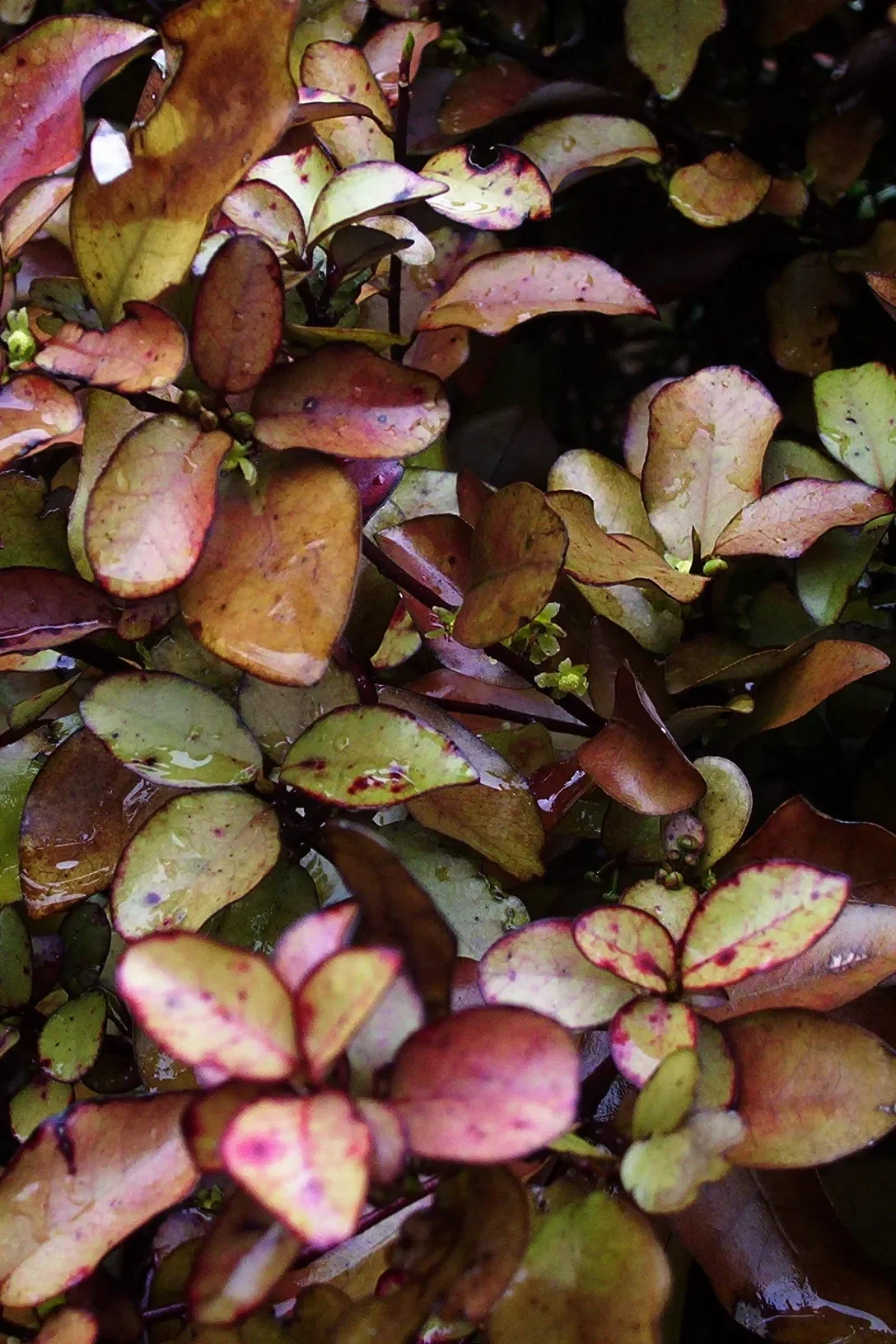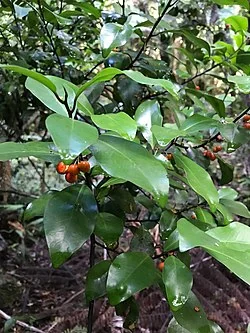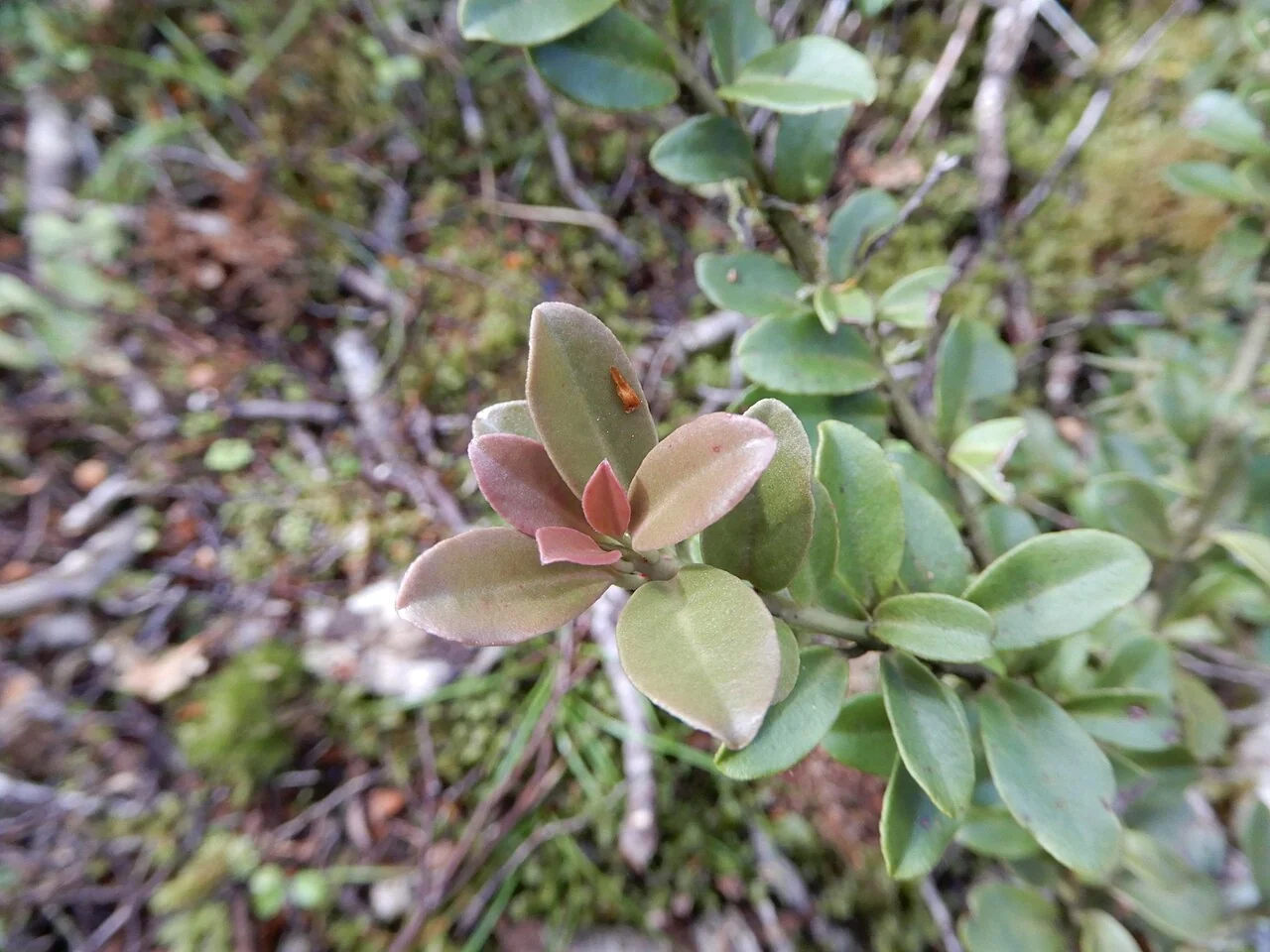
Horopito
Pseudowintera colorata
Introduction
Introduction Overview
Pseudowintera colorata , commonly known as Horopito or New Zealand Pepper Tree, is a distinctive native shrub renowned for its peppery-tasting leaves and striking red-mottled foliage. This hardy evergreen has been used traditionally by Māori for its medicinal properties and continues to be valued both for its ornamental appeal and its cultural significance. The plant 's natural defense compounds make it resistant to browsing and give it its characteristic hot taste. native trees .

Plant Description
Botanical Features
Horopito ( Pseudowintera colorata ), commonly known as mountain horopito, pepperwood, New Zealand pepper tree, or red horopito, is an evergreen shrub or small tree endemic to New Zealand. It typically grows as a shrub up to 3.5 meters tall, with upright trunks and branches and dark bark. Its most distinctive feature is its aromatic foliage. The leathery leaves are alternate, elliptic, and range from matt green to yellowish-green on the upper surface, often blotched with red, especially in exposed conditions. The undersides are glaucous to white and frequently pink-flushed. New leaves in spring can emerge bright red. The leaves are notably pungent and pepper-tasting, a characteristic that gives the plant its common names. This peppery taste is primarily due to a chemical component called polygodial, which also contributes to the plant's defense mechanisms against insects and fungi. Small, bisexual flowers, about 1 cm in diameter, appear in fascicles of 1-3 in the leaf axils. They have 5-6 linear to narrow-oblong, greenish-yellow petals. The fruit is a fleshy, globose to subglobose berry, 5-6 mm in diameter, which ripens to dark red or black and contains 2-3 seeds.
Quick Facts
Quick Facts Overview
| Scientific Name | Pseudowintera Colorata |
|---|---|
| Height | 1-2.5 m |
| Spread | 1-2 m |
| Water Needs | Moderate (moist, well-drained soil) |
| Light | Partial shade (tolerates full sun in cool climates) |
| Frost Tolerance | High (tolerates frost and occasional snow) |
| Salt Tolerance | Low |
| Growth Rate | Slow to moderate |
| Lifespan | Long-lived shrub |
Climate Best Suited to
Pseudowintera is native to New Zealand and thrives in the country's diverse climate conditions. It adapts well to various regional climates throughout the country.
Regional Suitability
| City | Climate Suitability |
|---|---|
| Whangārei | Ideal |
| Auckland | Ideal |
| Hamilton | Ideal |
| Tauranga | Ideal |
| Rotorua | Ideal |
| Gisborne | Ideal |
| New Plymouth | Ideal |
| Napier | Ideal |
| Whanganui | Ideal |
| Palmerston North | Ideal |
| Wellington | Ideal |
| Nelson | Ideal |
| Christchurch | Ideal |
| Dunedin | Ideal |
| Invercargill | Ideal |
Natural Habitat
Horopito is endemic to New Zealand and occurs naturally throughout the country, from sea level to subalpine regions. It is particularly common in the North Island and northern South Island, where it thrives in a variety of forest types.
Forest Types
The plant is most abundant in podocarp-broadleaf forests, where it forms an important component of the understorey layer. It also occurs in beech forests, particularly in the South Island, and can be found in regenerating forest areas and along forest margins.
Environmental Conditions
Horopito prefers cool, moist environments with high humidity and well-drained, acidic soils. It is commonly found in areas with annual rainfall of 1000-3000mm and can tolerate light frosts. The plant is shade-tolerant and often grows beneath the forest canopy, though it can also establish in more open areas.
Geographic Distribution
While horopito occurs throughout New Zealand, it is most abundant in the central and southern North Island, particularly in areas like the Central Plateau, Taranaki, and the Wellington region . In the South Island, it is common in Nelson, Marlborough, and the West Coast, becoming less frequent further south.
Plant Conservation
Conservation
Pseudowintera colorata , also known as mountain horopito or pepperwood, is a woody evergreen shrub or small tree endemic to New Zealand. It is found in coastal, lowland, or montane forest margins and shrublands across the North, South, and Stewart Islands. Despite its widespread distribution and presence in heavily browsed forests, Pseudowintera colorata is currently classified as "Not Threatened" according to the New Zealand Threat Classification System (NZTCS) as of 2023. This status has been consistent in previous assessments. Its unpalatability to browsers, due to its peppery leaves, is a factor contributing to its resilience. The plant is known for its yellowish-green leaves blotched with red, especially new leaves in spring, and its distinctive hot, peppery taste. It is a slow-growing plant that thrives in high rainfall areas.
Soil Requirements
Pseudowintera prefers well-draining soil with good organic content. It can adapt to various soil types but performs best in loamy or sandy soils.
Water Needs
Pseudowintera requires moderate watering, especially during establishment. Once established , it becomes more drought-tolerant.
Light Requirements
Pseudowintera grows best in full sun to partial shade, depending on the specific species and local climate conditions.
Temperature
Pseudowintera is well-adapted to New Zealand's temperate climate and can tolerate both warm summers and cool winters.
Planting Guide
When to Plant
The best time to plant Pseudowintera is during spring or autumn when soil temperatures are moderate and rainfall is reliable.
How to Plant
Dig a hole twice the width of the root ball and slightly deeper. Place Pseudowintera in the hole, backfill with soil, and water thoroughly. Mulch around the base to retain moisture.
Ecological Role
Horopito plays a vital role in New Zealand's native ecosystems, particularly in forest understorey communities where it contributes to biodiversity and ecosystem health.
Wildlife Habitat
The dense , evergreen foliage provides excellent shelter for small birds, particularly native species like fantails, silvereyes, and grey warblers. The berries are an important food source for native birds including tūī, bellbirds, and kererū, especially during autumn when other food sources may be scarce.
Insect Associations
Horopito supports various native insects, including native bees and butterflies that visit its flowers. The plant 's natural defense compounds help protect it from browsing by introduced mammals, making it an important component of forest regeneration areas.
Ecosystem Services
As an understorey species, horopito helps maintain soil moisture and provides ground cover that reduces erosion. Its presence in forest ecosystems contributes to the overall health and resilience of native plant communities, particularly in areas recovering from disturbance.
Uses and Applications
Pseudowintera has various practical and ornamental uses. From traditional Māori applications to modern landscaping, this versatile plant serves multiple purposes.
Traditional Uses
Historically, Pseudowintera was used by Māori for medicinal purposes, food, and cultural practices. These traditional uses reflect the deep knowledge of native plants.
Landscaping Uses
Landscaping Uses Overview
This plant is highly valued in landscaping for its aesthetic appeal and practical benefits. It can be used in various garden styles and landscape applications.
Seasonal Care
Spring
Spring is the ideal time to plant Pseudowintera as the soil warms and new growth begins. Water regularly to establish roots and apply a light mulch to retain moisture.
Summer
During summer , Pseudowintera may require additional watering during dry spells. Monitor for pests and provide shade if needed in hot climates.
Autumn
Autumn is perfect for transplanting Pseudowintera as the cooler temperatures reduce stress. Reduce watering as growth slows.
Winter
Winter care for Pseudowintera involves minimal maintenance. Protect from severe frosts if necessary and avoid overwatering.
- Plant in well-drained soil
- Apply light mulch
- Water regularly to establish roots
- Monitor for drought stress
- Provide shade in hot climates
- Check for pest infestations
- Transplant established plants
- Reduce watering as growth slows
- Collect seeds for propagation
- Protect from severe frosts
- Avoid overwatering
- Minimal maintenance required
Pruning
Pruning Techniques
- Prune after flowering to maintain shape and size
- Remove dead or damaged branches as needed
Shrubs respond well to regular trimming. Prune after flowering to maintain shape and encourage new growth.
How to Grow Horopito
Horopito, also known as New Zealand Pepper Tree, is a distinctive native shrub renowned for its peppery-tasting leaves and striking red-mottled foliage. This hardy evergreen has been used traditionally by Māori for its medicinal properties and continues to be valued both for its ornamental appeal and its cultural significance. The plant's natural defense compounds make it resistant to browsing and give it its characteristic hot taste. Understanding its propagation methods is key to successfully growing this unique species.
From Seed
Propagating Horopito from fresh seed is a viable method, though germination can be slow and may require stratification. Collect ripe seeds in late autumn or early winter. Clean the seeds thoroughly to remove any fleshy pulp. Sow the seeds in a tray filled with a well-draining seed-raising mix, lightly covering them. The seeds typically require a period of cold stratification (e.g., refrigerate for 2-3 months) to break dormancy. Maintain consistent moisture in the seed tray and keep it in a warm, sheltered location. Germination can take several weeks to months after stratification. Once seedlings have developed a few true leaves, they can be potted into individual containers and grown in a sheltered environment before planting out.
From Cuttings
Semi-hardwood cuttings are a reliable method for propagating Horopito, ensuring that new plants retain the exact characteristics of the parent. Take 10-15 cm cuttings from healthy, semi-hardwood stems in late summer or early autumn. Remove the lower leaves and dip the cut end in a rooting hormone. Insert the cuttings into a well-draining propagation mix (e.g., sand and perlite). Keep the cuttings in a warm, humid environment, out of direct sunlight, perhaps under a plastic dome or in a propagator. Rooting typically occurs within 8-12 weeks. Once rooted, the new plants can be potted on and grown in a sheltered environment until they are ready for planting.
Pests and Diseases
Common Pests
Pseudowintera is generally resistant to most pests due to its native adaptations. However, it may occasionally be affected by common garden pests such as aphids or scale insects.
Disease Prevention
To prevent diseases, ensure good air circulation around Pseudowintera and avoid overwatering. Remove any diseased plant material promptly to prevent spread.
Cultural Significance
Cultural Importance
Horopito Uses
Horopito (pepper tree) is noted for its hot, aromatic leaves used traditionally and in contemporary cuisine; it is a flagship species in māra rongoā plantings.
Pseudowintera colorata , commonly known as horopito or the New Zealand Pepper Tree, holds significant cultural importance, particularly for the Māori people of New Zealand. Its uses span traditional medicine, flavoring, and other practical applications. The plant has a long history of use in traditional Māori healing practices. Its leaves were applied topically to treat various skin conditions, including ringworm, venereal diseases, chaffing, wounds, bruises, and cuts. The sap was also utilized for skin ailments. Internally, a decoction made from the leaves was consumed to alleviate stomach aches and was widely known as "Māori Painkiller" or "Bushman's Painkiller." It was also employed for general pain relief, including toothaches. The plant's active compound, polygodial, contributes to its potent antimicrobial and anti-inflammatory properties, which were vital in ancient remedies for infections and digestive issues. Additionally, Māori women traditionally used crushed horopito leaves, rubbed on the breasts, to impart a bitter taste during the weaning of children. The distinctive peppery taste of horopito leaves has led to their increasing use as an indigenous flavoring in modern cuisine. Historically, the reddish wood of Pseudowintera colorata was used for inlay work. In the 19th century, its bark served as a substitute for quinine due to its stimulating tonic and astringent qualities. The plant also featured in commercial remedies; Mother Aubert, a French nun, incorporated horopito into her patent medicine, Karana, which became widely used in New Zealand during the late 19th century. As an ancient shrub endemic to New Zealand, Pseudowintera colorata is recognized as a distinctive native plant whose resilience and unique properties have made it a valuable resource for centuries.
Bonus Tip
Expert Growing Advice
Horopito ( Pseudowintera colorata ) is considered one of the world's oldest flowering plants, with fossils found in New Zealand dating back over 65 million years. It belongs to the Winteraceae family, a group of ancient flowering plants often found in regions that were once part of the supercontinent Gondwana. This ancient lineage highlights its unique evolutionary history and its significance in understanding plant evolution.






